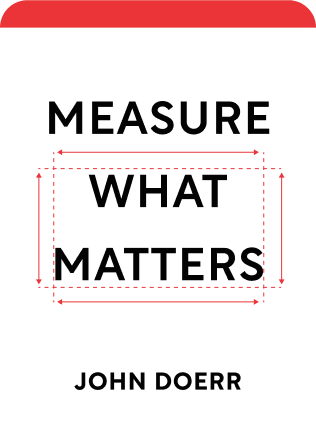

This article is an excerpt from the Shortform summary of "Measure What Matters" by John Doerr. Shortform has the world's best summaries of books you should be reading.
Like this article? Sign up for a free trial here .
What are key results, and what do they mean? How do you pick key results?
Key results are the benchmarks you establish when you write your OKRs. Your KRs will help you know if you’re going in the right direction, and will keep you on track for achieving your objectives.
Learn more about OKR key results below.
What Are Key Results?
Key results (KRs) are benchmarks toward the objective. In other words, they are the “how,” the steps you need to take to meet your goal. Here’s more about KRs, and key results examples.
OKR Key results:
- State the measurable sub-goals that, if achieved, will collectively result in achieving the objective
- Usually include numbers (revenue, market share, active users, growth, and so on)
- Are time-bound (they include specific deadlines)
- Are black-and-white—you either succeed in achieving a key result, or you don’t
- Are relatively challenging. If a key result seems easy, it, or your objective, may not be ambitious enough
Example:
Objective: Hire new employees to meet the needs of the expanding organization.
Key Result #1: Meet with 3 candidates this month for the role of director of finance and hire 1.
Key Result #2: Meet with 5 candidates this quarter for the role of marketing manager and hire 1.
Key Result #3: Meet with 5 candidates this quarter for the role of product manager and hire 1.
Companies that use this system have OKRs at every tier: Top-line OKRs for the entire company, division OKRs, team OKRs, and individual OKRs. Everyone in the company creates OKRs, and everyone’s OKRs are visible to everyone else. This creates some great key results examples.
Identify KRs
After you know your priorities, your objectives, you can start to plan how to achieve them. OKR key results are the steps that get you there. For each objective, decide on three to five results—sub-goals that are specific, measurable, and time-bound, and that collectively ensure you’ll attain your objective.
The three sets of (KRs) below are all proposed paths toward the objective of winning the Indy 500. What differentiates the strong KRs from the weak and so-so KRs? Look at these key results examples:
| Weak KRs | So-So KRs | Strong KRs |
| Objective: Win the Indy 500.KR #1: Achieve a faster lap speed.KR #2: Decrease time during pit stops. | Objective: Win the Indy 500.KR #1: Achieve a lap speed that’s 2% faster.KR #2: Decrease time during pit stops by an average of 1 second/stop. | Objective: Win the Indy 500.KR #1: Achieve a lap speed that’s 2% faster.KR #2: Decrease time during pit stops by an average of 1 second/stop.KR #3: Decrease pit stop errors by half.KR #4: Spend 1 hour/day practicing pit stops. |
The Problem with the Weak KRs: These KRs are measurable, but they aren’t specific. How much faster does your lap speed need to be to win the Indy 500? By how much time do you need to decrease pit-stop length?
The Problem with the So-So KRs: These KRs are better because they’re measurable and specific. In the beginning, many of your KRs will look like these, and that’s fine. But there’s still a problem. Achieving a faster lap speed is relatively straightforward, but how do you decrease your pit-stop time? The strongest KRs answer how.
Scoring OKRs: Choosing Great Key Results
At the end of the OKR cycle, you score and reflect on your OKRs. The wrap-up phase consists of three parts: objective scoring, subjective self-assessment, and reflection. As you’re deciding on key results, you’ll want to score your OKRs to pick your goals to track.
Objective Scoring
The employee and manager assign a score to the objectives. The simplest way to score an objective is to average the completion rates of its key results. One way to score is to use a scale of 0.0 to 1.0, based on how much of the key result was completed.
- 0.7-1.0 is a “green” score, meaning the individual or team achieved the goal.
- 0.4-0.6 is a “yellow” score, meaning the individual or team made progress but didn’t complete the goal.
- 0.0-0.3 is a “red” score, meaning the individual or team failed to make progress toward the goal.
Subjective Self-Assessment
Objective data are important, but they don’t always tell the whole story. Low numbers could conceal a strong effort, and strong numbers could be inflated.
For example, let’s say your objective is to recruit more customers, and one of your key results is to make 50 phone calls to potential customers. You end up making 35 phone calls, for an objective score of 0.7. On paper, this looks like a success. But if you waited until the last minute and rushed through your calls, signing only 1 new customer, the objective score of 0.7 isn’t really indicative of your performance.
For this reason, it’s important to balance objective scores with subjective self-assessments. Work with your manager to compare objective scores with the circumstances that led to them.
Reflection
To learn from your experiences and scores, use these questions as a jumping-off point for group discussion and self-reflection:
- Did you meet your objectives? If you did, what factors helped you be successful? If you didn’t, what roadblocks did you face?
- What have you learned that you want to keep in mind during the next OKR cycle?

———End of Preview———
Like what you just read? Read the rest of the world's best summary of John Doerr's "Measure What Matters" at Shortform .
Here's what you'll find in our full Measure What Matters summary :
- How Google uses OKRs to rally 100,000 employees in the right direction
- How to avoid setting useless OKRs, and how to set great ones
- Key subtle behaviors your team must master to make OKRs work






